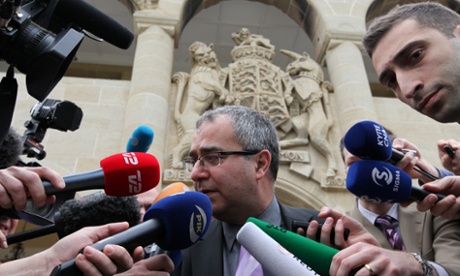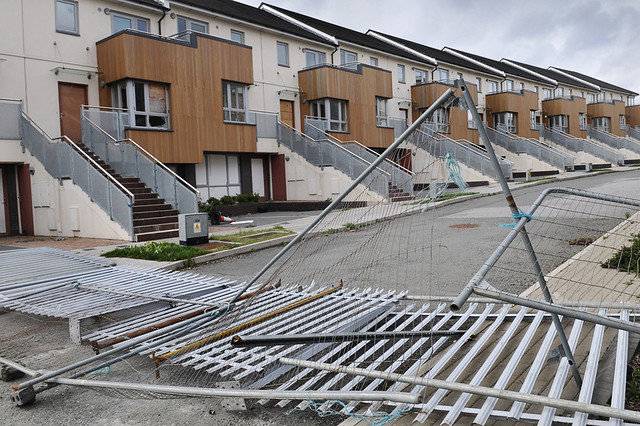Irish economy grew by just under 1% last year making it two years of growth Says the CSO


THE IRISH ECONOMY GREW BY JUST UNDER 1% LAST YEAR, MARKING TWO YEARS OF GROWTH, CSO OFFICIAL FIGURES HAVE REVEALED.
The Central Statistics Office (CSO) said the value of all goods and services, including the multinational sector, as measured by gross domestic product (GDP) grew by 0.9pc.
Officials said 2012 was the second year in succession that GDP outperformed the previous year following three years of recession from 2008 to 2010.
The homegrown business sector also had a successful year overall, with gross national product up 3.4pc over the course of last year.
The CSO study put the return to growth in the Irish economy down to significant gains in distribution, transport, software and communications.
There was also a small increase in the industrial sector but a large proportion of the overall growth was offset by huge 10pc falls in the value of agriculture, forestry and fisheries while public administration and defence decreased by 4.2pc last year.
Despite the fact that growth was flat in the second half of the year, official figures are likely to provide some welcome news for the Government as they are slightly ahead of the Central Bank forecasts of 0.7pc growth for 2012 issued in January.
The Bank’s outlook estimates growth of 1.3pc this year and 2.5pc next year.
Earlier this month, Finance Minister Michael Noonan noted that the country was entering another year of growth while the deficit is on a downward trajectory as we re-enter the bond markets to borrow money.
A spokesperson for the Department of Finance said the figures are in line with its forecast and confirm that the domestic economy stabilised in the second half of last year.
Cyprus close to agreeing bank restructure to save country from financial collapse
Thousands gather to protest outside parliament as talks continue
People queue up to make a transaction at an ATM outside a branch of Laiki Bank in Nicosia, Cyprus today.
Cyprus looks close to agreeing a new proposal to radically restructure its banking sector in a desperate effort to avoid default and financial collapse.
Under a proposal hammered out by Cypriot authorities and troika representatives, Cyprus’s second largest bank, Laiki may be closed and split into a “good” and “bad” bank.
The proposal could see Laiki’s “good” bank, comprising deposits of €100,000, merge with the country’s largest lender, Bank of Cyprus. The remaining, larger deposits would be hived off, leaving uninsured depositors facing potentially much larger write-downs than the 9.9 per cent levy proposed in the original EU-IMF deal proposed last Tuesday.
“The banking system needs restructuring otherwise it will go bankrupt and it needs to be done immediately,” Cyprus’s central bank governor Panicos Demetriades said, stressing that depositors below €100,000 would be protected and jobs saved.
A capital control bill, designed to prevent an outflow of deposits from Cyprus when banks re-open, went through Parliament tonight, giving the Cypriot minister of finance and Central Bankgovernor emergency powers to “take and impose temporary restrictive measures, including restrictions on capital controls.” This includes powers to limit withdrawals and transfers of money.
In addition, the government proposed the creation of a new investment fund, which would be funded by revenue from state assets to help the country raise a portion of the €5.8 billion demanded by the EU and IMF lenders.
In total, seven separate bills are under discussion in Parliament tonight as demonstrators protested outside parliament against the measures.
A chant of “Oxi, No, to taxes on deposits,” ran though the throng of people pushing against riot police manning the barricades. “Hands off Laiki,” others cried, including weeping bank staff and depositors.
Banks remain shut until Tuesday and ATMs were re-stocked with limited amounts of money. But rumours throughout the day of a closure of Laiki prompted long queues outside some banks, and protests by workers.
A €260 per day limit was implemented on ATM withdrawals in an effort to cope with demand for cash.
Today’s dramatic developments unfolded after the Eu ropean Central Bank threatened to withdraw emergency funding from Cypriot banks by Monday, effectively setting a deadline for the Mediterranean island to formulate a new bailout proposal.
With a second day of talks in Moscow between Cypriot finance minister Michael Sarrisand his Russian counterpart yielding no concrete proposals, today saw EU authorities re-assert control.
The ECB, which has been supporting Cyprus’s banks with emergency liquidity assistance, said the government had until Monday to get a deal in place. “Thereafter, Emergency Liquidity Assistance (ELA) could only be considered if an EU/IMF programme is in place that would ensure the solvency of the concerned banks,” it said.
With Cyprus’s financial system facing default , ratings agency Standard & Poor’s warned last night that the risk of a “disorderly credit event” in Cyprus was rising following the parliament’s rejection of the EU-IMF proposal on Tuesday. It lowered its long-term sovereign credit rating on Cyprus to ‘CCC’ from ‘CCC+’ with negative outlook.
Anticipated HSE savings on drug payments of €362m ‘did not happen’
A report published by the Public Accounts Committee said that it is clear that we are still paying more than other OECD countries.
A report published today by the Public Accounts Committee has found that some €362 million in savings anticipated in the HSE’s budget for last year did not happen.
The savings were supposed to be made in respect of drug payments, extra private income and the use of agency staff.
The report said that the HSE is not in a position to identify the number of its former staff who are now employed as agency staff and working in the public health system. It also said that the cost of employing an agency worker is similar to the cost of directly employing that worker.
On the issue of drugs payments the report referred to the 16 per cent of Ireland’s health budget that is used to purchase drugs, whereas in the UK, the figure is 9 per cent. A sum of €50 million would be saved annually if the price the HSE paid for drugs was the same as the price paid by the NHS in the UK.
Speaking today, chairman of the committee John McGuinness said that “it is clear that while there is likely to be savings arising from the October Agreement with the Irish Pharmaceutical Healthcare Association, we are still paying more for drugs than otherOECD countries and there is a need to publish annually these figures so that we can get a handle on how much extra we are paying.”
The committee recommended that a review of the model being used to determine the budget allocation of the HSE in 2012 should be undertaken given that some of the anticipated savings never materialised. McGuinness said that a better way to present estimates might beto make provision for the full cost and then, on negotiation of a reduction, deem it a saving at the year end.
Minister Pat Rabbitte defends the inclusion of houses in some ghost or unfinished estates
PAT RABBITTE INSISTS STANDARD METHODOLOGY WAS APPLIED FOR ALL ESTATES
Minister for Communications Pat Rabbitte has defended the inclusion of people living in unfinished housing estates in the property tax regime.
Mr Rabbitte said it related to the improved performance in finishing previously unfinished estates and the application of a standard, nationwide methodology of assessment.
“The purpose of the tax is to broaden the tax base so that the Government can avoid putting additional taxes on income and people at work,” he added.
Mr Rabbitte said it would not be fair that some citizens would have to pay the tax while others were exempt.
The Minister added that he had been assured by the Department of the Environment that it had gone through the estates, one by one, and had taken decisions based on the current standards.
The Minister was replying in the Dáil today to Fianna Fáil finance spokesman Michael McGrath who said thousands of people were receiving letters from the Revenue Commissioners with an estimate of their liability to pay the tax.
“We learn today that seven out of the eight people living in unfinished housing estates, who were exempt from the household charge last year, are now going to have to pay property tax,” he added.He said the number exempt living in unfinished developments had spectacularly dropped from 43,000 to 5,000, simply because Minister for the Environment Phil Hogan had instructed local authorities to go into every unfinished development and identify the houses which should or should not be exempt.
“We now have a situation where one family living in an unfinished housing estate, who is lucky enough to have a footpath outside the door and maybe a public light that works, will have to pay the property tax,’’ he added.
“But another family, around the corner in the same estate, who might be looking out on a heap of rubble, on what was supposed to be a green area, will now get an exemption.
Mr McGrath said the Minister was using the national housing development survey report to justify the dramatic drop in the number of people who would be allowed to avail of an exemption. But the report had cited 1,100 unfinished developments in a seriously problematic condition.
Sinn Féin deputy leader Mary Lou McDonald said the Minister was asking the Dáil to accept that in less than a year the number of unfinished estates had more than halved.
Many parents but? All that really matters is a healthy baby
For families touched by the miseries of mitochondrial disease, help may be at hand
Mitochondria are the tiny factories in our cells that produce the fuel of life
I held four-month-old Isobel for the briefest of moments, while her mother, whom I was interviewing last year, made a cup of coffee. Isobel (not her real name) was a wriggling, cherished mass of chubbiness, her whole life ahead of her. That “whole life” lasted less than a year, cut short by mitochondrial disease. Isobel’s cellular batteries had run out; the mitochondria, the tiny power factories in each of her cells, were failing to produce adenosine triphosphate, the fuel of life. If you are the parent of a baby with an incurable mitochondrial disease, each growth milestone is a tick closer to midnight, when the energy demands become insurmountable and hospital consultants can offer only condolences.
That is why the recent public consultation over “three-parent babies” by the Human Fertilisation and Embryology Authority is so welcome. The HFEA revealed this week that there is broad public support for a new, IVF-based technique to enable babies to be born with healthy mitochondria. It will now, rightly, advise ministers that research should proceed – with careful checks and balances, including licensing of clinics and maintaining anonymity for donors.
The new technique, called pronuclear transfer, works like this: couples at risk of passing on mitochondrial disease first undergo IVF to create embryos. Since faulty mitochondrial DNA (mtDNA, which produces defective mitochondria) is transmitted through the mother’s egg, the idea is to “rehome” that embryo in a healthy donor egg. To achieve that, the nuclear genetic material must be removed from a fertilised donor egg and the nuclear genetic material from the affected couple’s embryo inserted. The result is that the embryo has the nuclear DNA from the affected couple – but the healthy mtDNA of the egg donor.
That is what has given rise to talk of a third parent; but it is a distraction. I admire the headline writer who came up with “mito mum”, as the third parent has been nicknamed – it was a brilliant ruse for alerting the public to a technically difficult discussion. In terms of an ethical dilemma, however, mito mum was a ghostly figment, a spectral mother kept in the public eye to symbolise opposition to all forms of biological tinkering. If we were pedants, then we would all have to admit to having three parents: mum, dad and our mysterious mito mum. The mtDNA that powers each of us has come down the maternal line; I inherited mine from my mother, and I have passed it on to my children.
My daughter will transmit her mtDNA to her children, and so on. So who was the original source of the Ahuja mtDNA? Not me, nor my mother, nor my maternal grandmother. We are all, in this lineage, carriers of the same mtDNA (except for chance mutations among generations). I can hardly claim sole ownership of it, and it is therefore illogical to argue that my identity is uniquely bound up with it. Grateful though I am to the “ancestral mum” who bequeathed her daughters the mitochondrial tool-kit for survival, it is not to her that I look for my identity.
That stems, instead, from the organism that my mitochondria allows me to be. That organism betrays its true genetic parentage: my mother’s modest stature and my father’s immodest nose. And consider this: mtDNA has 37 genes, while your nuclear DNA has 23,000. That’s less than 2 per cent of your unabridged genome.
I once asked Professor Susan Golombok, a Cambridge University psychologist who has studied the welfare of children born through fertility treatment, about what she thought of the three-parent fuss. It all boiled down, she said, to how society defined a parent: “We already have children whom we can describe as having five parents: the egg donor, the sperm donor, the surrogate mother, and the couple that brings the child up.” Parenting, she concluded, was about more than just genes; in fact, even nuclear DNA matters less than we think. Children created using donated sperm or eggs are normal, healthy, well-adjusted and even show surprisingly little interest in tracing their biological parents. Maybe we shouldn’t find it strange: these children are loved by parents who have triumphed over adversity to have them.
That is surely what the best parenting is about – unconditional love. Anyone who believes in family and society, and in the virtues of kindness and compassion, should support the world-leading research done in this country to eradicate mitochondrial disease, which affects 6,000 people in the UK, including those with muscular dystrophy. It is true that the technique involves the creation and destruction of a fertilised donor egg; that is why the HFEA recommends it for the prevention of serious disease only. It will require a law change; in a proviso originally intended to prevent human cloning and designer babies, legislation prohibits the implantation of an embryo whose nuclear DNA or mtDNA has been altered.
Caution should always tug at the hems of experimental science, especially where techniques concern the creation of new life and when the ramifications are far-reaching. For the first time, we will be able to reach into the future and change the mtDNA not just of a baby girl, but all her descendants. The risks are there but, for people like Isobel’s parents, who long to start a family anew, the potential rewards are immeasurable.
Big Bang’s afterglow reveals an older universe which is 80 million years old


New results from looking at the split-second after the Big Bang indicate the universe is 80 million years older than previously thought.
The universe has hidden its age well. The European Space Agency’s Planck space telescope has scanned the skies for the Big Bang’s fingerprint and discovered that the universe is about 100 million years older than thought, and that there’s more normal matter and dark matter filling the cosmos.
The findings announced Thursday by ESA and NASA peg the universe’s age at 13.8 billion years, and produced a multicolored map showing the tiny temperature fluctuations that reveal the seeds of the universe’s future structure.
“It might look a little bit like a dirty rugby ball or a piece of modern art,” ESA’s George Efstathiou, aCambridge University astrophysicist, said in a press conference early Thursday morning. “But I can assure you there are cosmologists who would have hacked our computers or maybe even given up their children to get hold of a copy of this map.”
The Planck mission is a successor to NASA’s Wilkinson Microwave Anisotropy Probe (WMAP) and the Cosmic Background Explorer (COBE), and it takes our snapshot of the early universe’s afterglow to unprecedented clarity.
“It’s as if we’ve gone from a standard television to a high-definition television,” NASA astrophysics director Paul Hertz said in a later press conference. “New and important details have become crystal clear.”
The map represents the first 15.5 months of observation by the Planck space telescope, which looked at the universe’s cosmic microwave background — that extremely cold, barely noticeable glow left after the Big Bang when the universe was just a cosmic baby — about 380,000 years old.
Although it’s cold now, this afterglow is an imprint from when the young universe’s soup of particles heated to about 4,900 degrees Fahrenheit, stretched across the skies during a period of expansion known as inflation, and cooled over the intervening billions of years to just a few degrees above absolute zero.
Since the light’s path is affected by all the mass around it, the new radiation map also allows scientists to create a map of all the mass in the universe, scientists said.
“We can see the subtle effects of the gravitational pulls from literally everything in the universe,” said U.S. Planck project scientist Charles Lawrence, based at Jet Propulsion Laboratory. “That tells us about … everything in the universe.”
The researchers found that they could raise the estimates of normal matter in the universe to 4.9%, up from 4.6%. The dark matter share rose to 26.8%, up from 24%. The overwhelming majority, dark energy – that strange force that’s causing the universe to expand faster and faster – shrunk accordingly, from 71.4% to 68.3%.
And with less dark energy to push things apart, the universe isn’t expanding quite as quickly as thought, the scientists found.
The map is colored in shades from blue (for colder spots) to yellow to red (for warmer spots). But the differences between cold and warm are infinitesimally small, on the order of 100 millionths of a degree.
“The contrasts are turned way up,” Lawrence said.
The Planck spacecraft’s data also highlight two other mysteries: why the heat from the background radiation isn’t evenly distributed, and what could have caused a strange cold spot in the map, now revealed to be even larger than previous estimates.








No comments:
Post a Comment